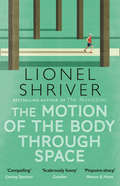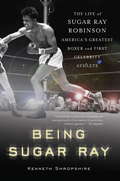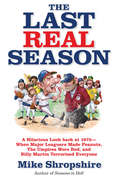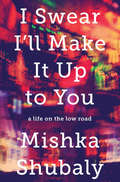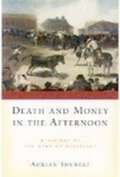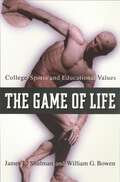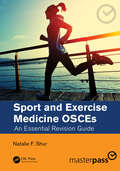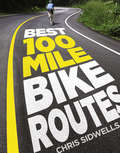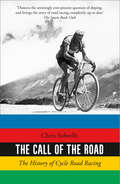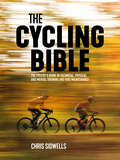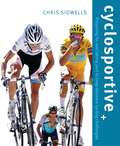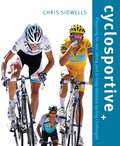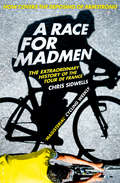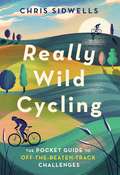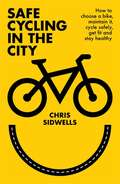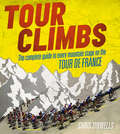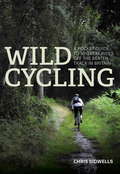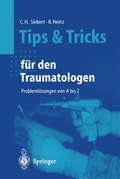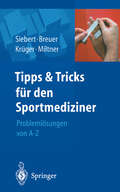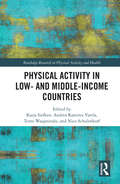- Table View
- List View
The Motion of the Body Through Space
by Lionel ShriverFrom the Orange Prize-winning author of We Need to Talk About Kevin
Being Sugar Ray: Sugar Ray Robinson, America's Greatest Boxer and First Celebrity Athlete
by Kenneth ShropshireMuhammad Ali memorably referred to Sugar Ray Robinson as "the king, the master, my idol,” and rarely a fight fan has chosen to argue too much with those words. With a career spanning three decades, multiple championships, over two hundred fights (without once taking a 10-count), and more victories than Joe Louis and Ali combined it was no surprise when RING magazine named Robinson "pound for pound, the best boxer of all time.” In Being Sugar Ray, acclaimed scholar Kenneth Shropshire contends that Sugar Ray Robinson's influence extends far beyond the ring. It was Robinson who introduced America to the athlete as entrepreneur and celebrity. From his business empire to his prized flamingo pink Cadillac, described as the Hope Diamond of Harlem, Sugar Ray was the trailblazer whom every athlete since has been trying, consciously or otherwise, to emulate.
Being Sugar Ray: The Life of Sugar Ray Robinson, America's Greatest Boxer and the First Celebrity Athlete
by Kenneth ShropshireAnd in this corner, hailing from Black Bottom, Detroit by way of Harlem, with more victories than Joe Louis and Muhammad Ali combined, the greatest fighter-pound for pound-of all time: Sugar Ray Robinson. If imitation is truly the sincerest form of flattery then there should be little doubt Sugar Ray Robinson is the greatest and most influential American boxer of all time. Fighters (and the occasional alt-rock band) have been adopting his name, and trying to imitate his inimitable fighting style for decades. Sugar Ray Robinson transcended race and sport to become a celebrity athlete in a way that no one-white or black-had accomplished before him. From his business empire to his prized flamingo pink Cadillac, described as the Hope Diamond of Harlem, Kenneth Shropshire shows Sugar Ray was the trailblazer whom every athlete since has been trying, consciously or otherwise, to emulate.
The Last Real Season: A Hilarious Look Back at 1975 - When Major Leaguers Made Peanuts, the Umpires Wore Red, and Billy Martin Terrorized Everyone
by Mike ShropshireThere are baseball books and there are baseball books. But for the baseball cognoscenti, there are just a few "must-have" classics:Ball Four by Jim Bouton. The Long Season by Jim Brosnan. Willie's Time by Charles Einstein. And Seasons In Hell by Mike Shropshire, which was a hilarous first-person account of Mike's travails serving as a daily beat writer covering the hapless 1972 Texas Rangers. Now, in The Last Real Season, Shropshire captures the essence of a different time and different place in baseball, when the average salary for major leaguers was only $27,600...when the ballplayers' drug of choice was alcohol, not steroids...when major leaguers sported tight doubleknit uniforms over their long-hair and Afros...and on July 28th, 1975, the day that famed Detroit resident Jimmy Hoffa went missing, the Detroit Tigers started a losing streak of 19 games in a row. On the day that the Tigers blew a 4-run lead in the bottom of the ninth, Shropshire recalls: "I drank three bottles of Stroh's beer in less than a minute and wrote that 'Jimmy Hoffa will show up in the left field stands with Amelia Earhart as his date before the Tigers will win another game.'" And so it goes. Filled with just the kind of wonderful baseball stories that real fans crave, this is the funniest baseball book of the year.
I Swear I'll Make It Up to You: A Life on the Low Road
by Mishka ShubalyAn odyssey of family, heartbreak, violence, punk rock, brokenness, broke-ness, sex, love, loss, drinking, drinking, drinking, and an unlikely savior: distance running.A misfit kid at the best of times, Mishka Shubaly had his world shattered when, in a twenty-four-hour span in 1992, he survived a mass shooting on his school's campus, then learned that his parents were getting divorced. His father, a prominent rocket scientist, abandoned the family and their home was lost to foreclosure. Shubaly swore to avenge the wrongs against his mother, but instead plunged into a magnificently toxic love affair with alcohol.Almost two decades later, Shubaly's life changed again when a fateful five-mile run after a bar fight inspired him to clean up his life. And when he finally reconnected with his estranged father, he discovered the story of his childhood was radically different from what he thought he knew.In this fiercely honest, emotional, and self-laceratingly witty book, Shubaly relives his mistakes, misfortunes, and infrequent good decisions: the disastrous events that fractured his life; his incendiary romances; his hot-and-cold career as a rock musician; meeting his newborn nephew while out of his gourd on cough syrup. I Swear I'll Make It Up to You is an apology for choices Shubaly never thought he'd live long enough to regret, a journey so far down the low road that it took him years of running to claw his way back.
Death and Money in The Afternoon: A History of the Spanish Bullfight
by Adrian ShubertBullfighting has long been perceived as an antiquated, barbarous legacy from Spain's medieval past. In fact, many of that country's best poets, philosophers, and intellectuals have accepted the corrida as the embodiment of Spain's rejection of the modern world. In his brilliant new interpretation of bullfighting, Adrian Shubert maintains that this view is both the product of myth and a complete misunderstanding of the real roots of the contemporary bullfight. While references to a form of bullfighting date back to the Poem of the Cid (1040), the modern bullfight did not emerge until the early 18th century. And when it did emerge, it was far from being an archaic remnant of the past--it was a precursor of the 20th-century mass leisure industry. Indeed, before today's multimillion-dollar athletes with wide-spread commercial appeal, there was Francisco Romero, born in 1700, whose unique form of bullfighting netted him unprecedented fame and wealth, and Manuel Rodriguez Manolete, hailed as Spain's greatest matador by the New York Times after a fatal goring in 1947. The bullfight was replete with promoters, agents, journalists, and, of course, hugely-paid bullfighters who were exploited to promote wine, cigarettes, and other products. Shubert analyzes the business of the sport, and explores the bullfighters' world: their social and geographic origins, careers, and social status. Here also are surprising revelations about the sport, such as the presence of women bullfighters--and the larger gender issues that this provoked. From the political use of bullfighting in royal and imperial pageants to the nationalistic "great patriotic bullfights" of the late 19th and early 20th centuries, this is both a fascinating portrait of bullfighting and a vivid recreation of two centuries of Spanish history. Based on extensive research and engagingly written, Death and Money in the Afternoon vividly examines the evolution of Spanish culture and society through the prism of one of the West's first--and perhaps its most spectacular--spectator sports.
Death and Money in The Afternoon: A History of the Spanish Bullfight
by Adrian ShubertBullfighting has long been perceived as an antiquated, barbarous legacy from Spain's medieval past. In fact, many of that country's best poets, philosophers, and intellectuals have accepted the corrida as the embodiment of Spain's rejection of the modern world. In his brilliant new interpretation of bullfighting, Adrian Shubert maintains that this view is both the product of myth and a complete misunderstanding of the real roots of the contemporary bullfight. While references to a form of bullfighting date back to the Poem of the Cid (1040), the modern bullfight did not emerge until the early 18th century. And when it did emerge, it was far from being an archaic remnant of the past--it was a precursor of the 20th-century mass leisure industry. Indeed, before today's multimillion-dollar athletes with wide-spread commercial appeal, there was Francisco Romero, born in 1700, whose unique form of bullfighting netted him unprecedented fame and wealth, and Manuel Rodriguez Manolete, hailed as Spain's greatest matador by the New York Times after a fatal goring in 1947. The bullfight was replete with promoters, agents, journalists, and, of course, hugely-paid bullfighters who were exploited to promote wine, cigarettes, and other products. Shubert analyzes the business of the sport, and explores the bullfighters' world: their social and geographic origins, careers, and social status. Here also are surprising revelations about the sport, such as the presence of women bullfighters--and the larger gender issues that this provoked. From the political use of bullfighting in royal and imperial pageants to the nationalistic "great patriotic bullfights" of the late 19th and early 20th centuries, this is both a fascinating portrait of bullfighting and a vivid recreation of two centuries of Spanish history. Based on extensive research and engagingly written, Death and Money in the Afternoon vividly examines the evolution of Spanish culture and society through the prism of one of the West's first--and perhaps its most spectacular--spectator sports.
The Game of Life: College Sports and Educational Values
by James L. Shulman William G. BowenThe President of Williams College faces a firestorm for not allowing the women's lacrosse team to postpone exams to attend the playoffs. The University of Michigan loses $2.8 million on athletics despite averaging 110,000 fans at each home football game. Schools across the country struggle with the tradeoffs involved with recruiting athletes and updating facilities for dozens of varsity sports. Does increasing intensification of college sports support or detract from higher education's core mission? James Shulman and William Bowen introduce facts into a terrain overrun by emotions and enduring myths. Using the same database that informed The Shape of the River, the authors analyze data on 90,000 students who attended thirty selective colleges and universities in the 1950s, 1970s, and 1990s. Drawing also on historical research and new information on giving and spending, the authors demonstrate how athletics influence the class composition and campus ethos of selective schools, as well as the messages that these institutions send to prospective students, their parents, and society at large. Shulman and Bowen show that athletic programs raise even more difficult questions of educational policy for small private colleges and highly selective universities than they do for big-time scholarship-granting schools. They discover that today's athletes, more so than their predecessors, enter college less academically well-prepared and with different goals and values than their classmates--differences that lead to different lives. They reveal that gender equity efforts have wrought large, sometimes unanticipated changes. And they show that the alumni appetite for winning teams is not--as schools often assume--insatiable. If a culprit emerges, it is the unquestioned spread of a changed athletic culture through the emulation of highly publicized teams by low-profile sports, of men's programs by women's, and of athletic powerhouses by small colleges. Shulman and Bowen celebrate the benefits of collegiate sports, while identifying the subtle ways in which athletic intensification can pull even prestigious institutions from their missions. By examining how athletes and other graduates view The Game of Life--and how colleges shape society's view of what its rules should be--Bowen and Shulman go far beyond sports. They tell us about higher education today: the ways in which colleges set policies, reinforce or neglect their core mission, and send signals about what matters.
The Game of Life: College Sports and Educational Values
by James L. Shulman William G. BowenThe President of Williams College faces a firestorm for not allowing the women's lacrosse team to postpone exams to attend the playoffs. The University of Michigan loses $2.8 million on athletics despite averaging 110,000 fans at each home football game. Schools across the country struggle with the tradeoffs involved with recruiting athletes and updating facilities for dozens of varsity sports. Does increasing intensification of college sports support or detract from higher education's core mission? James Shulman and William Bowen introduce facts into a terrain overrun by emotions and enduring myths. Using the same database that informed The Shape of the River, the authors analyze data on 90,000 students who attended thirty selective colleges and universities in the 1950s, 1970s, and 1990s. Drawing also on historical research and new information on giving and spending, the authors demonstrate how athletics influence the class composition and campus ethos of selective schools, as well as the messages that these institutions send to prospective students, their parents, and society at large. Shulman and Bowen show that athletic programs raise even more difficult questions of educational policy for small private colleges and highly selective universities than they do for big-time scholarship-granting schools. They discover that today's athletes, more so than their predecessors, enter college less academically well-prepared and with different goals and values than their classmates--differences that lead to different lives. They reveal that gender equity efforts have wrought large, sometimes unanticipated changes. And they show that the alumni appetite for winning teams is not--as schools often assume--insatiable. If a culprit emerges, it is the unquestioned spread of a changed athletic culture through the emulation of highly publicized teams by low-profile sports, of men's programs by women's, and of athletic powerhouses by small colleges. Shulman and Bowen celebrate the benefits of collegiate sports, while identifying the subtle ways in which athletic intensification can pull even prestigious institutions from their missions. By examining how athletes and other graduates view The Game of Life--and how colleges shape society's view of what its rules should be--Bowen and Shulman go far beyond sports. They tell us about higher education today: the ways in which colleges set policies, reinforce or neglect their core mission, and send signals about what matters.
Sport and Exercise Medicine OSCEs: An Essential Revision Guide
by Natalie F. ShurAs the only text on the market for Sport and Exercise Medicine objective structured clinical examinations (OSCEs), this is an invaluable guide for those studying sport and exercise medicine and sitting examinations. Whilst specifically targeted at the OSCE, this book will have much wider appeal throughout the clinical setting. Sport and Exercise Medicine is a new and developing specialty and there has been a rapid increase in the number of universities offering MSc degrees in Sport and Exercise Medicine and more candidates year on the year sitting the Faculty of Sport and Exercise Medicine (FSEM) diploma exam. It is a niche specialty, with very little content taught at an undergraduate level, therefore knowing the material that is examined is often challenging compared with other specialties. This book provides the content to fill that need. The book is divided into sections based on the main topics that arise in sport and exercise medicine OSCEs, with both core knowledge and practical tips to ensure a fluid and confident performance by the examinee in every station. A wide range of readers will benefit from this book, including those about to sit a postgraduate examination in sport and exercise medicine or those enrolled in a postgraduate certificate or master’s course in the specialty. It will also be useful to doctors and allied healthcare professionals, such as physiotherapists, sports therapists, podiatrists and nurses, as well as undergraduate students. Further, the young clinician who is just starting out and wants to build their confidence in musculoskeletal assessment and presenting to seniors will gain much from reading this book.
Sport and Exercise Medicine OSCEs: An Essential Revision Guide
by Natalie F. ShurAs the only text on the market for Sport and Exercise Medicine objective structured clinical examinations (OSCEs), this is an invaluable guide for those studying sport and exercise medicine and sitting examinations. Whilst specifically targeted at the OSCE, this book will have much wider appeal throughout the clinical setting. Sport and Exercise Medicine is a new and developing specialty and there has been a rapid increase in the number of universities offering MSc degrees in Sport and Exercise Medicine and more candidates year on the year sitting the Faculty of Sport and Exercise Medicine (FSEM) diploma exam. It is a niche specialty, with very little content taught at an undergraduate level, therefore knowing the material that is examined is often challenging compared with other specialties. This book provides the content to fill that need. The book is divided into sections based on the main topics that arise in sport and exercise medicine OSCEs, with both core knowledge and practical tips to ensure a fluid and confident performance by the examinee in every station. A wide range of readers will benefit from this book, including those about to sit a postgraduate examination in sport and exercise medicine or those enrolled in a postgraduate certificate or master’s course in the specialty. It will also be useful to doctors and allied healthcare professionals, such as physiotherapists, sports therapists, podiatrists and nurses, as well as undergraduate students. Further, the young clinician who is just starting out and wants to build their confidence in musculoskeletal assessment and presenting to seniors will gain much from reading this book.
Best 100-Mile Bike Routes
by Chris SidwellsCompleting one hundred miles by bike is a timeless challenge. Ever since the invention of a pedal- powered, two-wheel vehicle, 100 miles has been the benchmark by which cyclists can measure their prowess.
The Call of the Road: A Complete History Of Cycle Road Racing
by Chris SidwellsEddy Merckx. Fausto Coppi. Jacques Anquetil. Bernard Hinault. Beryl Burton. Marianne Vos.
The Cycling Bible: The cyclist’s guide to technical, physical and mental training and bike maintenance
by Chris SidwellsThe Cycling Bible by renowned cycling author and journalist Chris Sidwells is a comprehensive guide to help you get the most out of cycling, whether you go road cycling, gravel riding, mountain biking or enjoy any other kind of two-wheeled fun.Based on the author’s extensive experience and research, this book collates the knowledge you will need to specifically train for the technical, physical and mental aspects of cycling training. It includes riding positions, strength and conditioning, endurance training, the psychological side of training, tailoring nutrition to your goals and bringing it all together to create your own training plan. It also deals with choosing the right bike for you, making essential safety checks and carrying out maintenance.Extensively illustrated, packed full of action photos, The Cycling Bible will help and motivate you to improve and develop as a cyclist and find even more joy in this fantastic sport.
Cyclosportive: Preparing For and Taking Part in Long Distance Cycling Challenges
by Chris SidwellsCyclosportives, or long-distance cycle rides, are growing in popularity all over the world. From the Etape du Tour - where cyclists get to ride a stage of the Tour de France - to the Tour of Flanders or the Etape Caledonia in Scotland, these events are pulling big numbers and attracting a range of cyclists. In this new book, bestselling author Chris Sidwells explains how to choose the right sportive, prepare for it both mentally and physically, and get yourself and your bike to the finish line. Topics include:- What kind of bike to buy- How to set up your optimal riding position- How to care for your bike- Clothing and equipment- Skills and techniques- Mental and physical demands of the eventWhether you're embarking on your first sportive or trying to improve on your performance in the next one, this essential guide will help you reach your goal. Written by an experienced cyclist, trainer and writer and full of information, tips, illustrations and great stories, it's the perfect companion to an unforgettable challenge.
Cyclosportive: Preparing For and Taking Part in Long Distance Cycling Challenges
by Chris SidwellsCyclosportives, or long-distance cycle rides, are growing in popularity all over the world. From the Etape du Tour - where cyclists get to ride a stage of the Tour de France - to the Tour of Flanders or the Etape Caledonia in Scotland, these events are pulling big numbers and attracting a range of cyclists. In this new book, bestselling author Chris Sidwells explains how to choose the right sportive, prepare for it both mentally and physically, and get yourself and your bike to the finish line. Topics include:- What kind of bike to buy- How to set up your optimal riding position- How to care for your bike- Clothing and equipment- Skills and techniques- Mental and physical demands of the eventWhether you're embarking on your first sportive or trying to improve on your performance in the next one, this essential guide will help you reach your goal. Written by an experienced cyclist, trainer and writer and full of information, tips, illustrations and great stories, it's the perfect companion to an unforgettable challenge.
A Race for Madmen: A History Of The Tour De France
by Chris SidwellsNo sporting event has had its past and present, its highs and lows so intricately entwined with those of a country like the Tour has with France.
Really Wild Cycling: The pocket guide to off-the-beaten-track challenges (Wild Cycling)
by Chris SidwellsAn illustrated pocket guide to off-the-beaten-track cycling challengesReally Wild Cycling follows in the tracks of Chris's bestselling Wild Cycling. Most, if not all, the rides are off-road, but each one presents a challenge to inspire readers to train for it and have a go. Most take only a few hours, but some are longer, and a few much longer, taking even the fittest several days. An introduction explains safety techniques and underlines the skills, knowledge, equipment and fitness levels required. The rides are graded in ascending difficulty within each region. Each ride suggests regular escape points to get riders to a safe place should the weather close in and draws attention to places where extra care should be taken. Some rides are on marked routes, like the Trans-Pennine Trail, some are races or organised challenges, while others are routes the author himself has mapped out. Each ride is illustrated with photos, an annotated map and a profile of the terrain. The text includes a detailed route guide and historical, geological and natural points of interest.
Safe Cycling in the City: How to choose a bike, maintain it, cycle safely, get fit and stay healthy
by Chris SidwellsThis is an urban and commuting cyclist's handbook, both inspirational and practical, showing us how to live safer, more enjoyable and healthier lives, both physically and mentally, while reducing our impact on the planet.Author of numerous bestselling bike books, Chris Sidwells, begins with a brief introduction which shows how cycling is already forming a crucial part of future urban transport, good for the environment as well as our health. Current urban transport models, heavily dependent as they are on cars, are unsustainable both in terms of our health and the environment. Cycling offers the perfect mass transport, health and wellbeing solution. As well as being an easy way to improve the fitness of the whole family, with some simple know-how, which Chris shares in this book, it can be perfectly safe even in busy cities. Increasingly, local authorities are seeing the essential role that cycling has to play in transport infrastructure; Chris looks at the many different schemes, both financial and infrastructural, to encourage people onto bikes. Commuting by bike also offers a financial benefit to individuals and societies.Chris shows how to get the right bike for you for commuting and urban cycling, whether that's an electric-assisted bike or pedal-powered only, and how to adjust it properly for your unique build. He looks at cycling clothing and accessories, including helmets, masks, locks and safety equipment. Chris explains how to keep cycling safely despite inclement weather and the different ways to transport what you need to and from work. A chapter on bike care and maintenance shows how to carry out basic repair jobs like adjusting gears, mending punctures and adjusting brakes.Chris explains cycling skills to give you confidence when cycling, including bike control, braking and how to make the most of your gears. He shows when and how to use the extra power provided by an electric bike and offers encouragement to new and returning cyclists.An extended chapter covers road safety, perhaps the biggest barrier to people commuting by bike. Chris shows how to co-exist safely with other road users and the potential hazards that every cyclist should be aware of. He explains the rules that every cyclist must follow and gives step-by-step guidance on how to carry out manoeuvres on the road.Chris shows how to choose the best route to and from work. He gives details of the various schemes to encourage commuting by bike, including insurance and where to find information.Cycling is regarded by many as the best way to regain and maintain fitness. As well as improving both physical and mental wellbeing, cycling can boost our immune system. Cycling also gives self-sufficiency and enhances self esteem.
Tour Climbs: The Complete Guide To Every Mountain Stage On The Tour De France
by Chris SidwellsThe first book to cover in detail every major climb ever used in the Tour de France, including detail on the actual route (with maps and profile), length, height, list of winners and route descriptions of how to emulate the King of the Mountains and get from the bottom to the top.
Wild Cycling: A pocket guide to 50 great rides off the beaten track in Britain (Wild Cycling)
by Chris Sidwells'A wildly inspiring adventure - from armchair to saddle.'Nichiless 'A lovely concise guide.'A. W. BairdHere is plenty of inspiration for anyone who loves to ride off road and get out into the wild and stunning scenery of the British mainland. Each route suggests further routes and the book as a whole introduces the wild cyling potential of a range of different locations. These natural routes to wild places link country lanes, green lanes, bridleways, towpaths, trails and often ancient ways between places. The book is illustrated in colour and each ride includes an annotated route map and ride profile, also OS grid references. And a fact file gives further indispensable details, including an indication of how hard each ride is, and how wild. From Chalk Cliffs and Curious Sound Mirrors in the south-east to Cape Wrath in the north-west, the purity, beauty and essential wildness of these rides will ensure that over the years many of them will become classic, even legendary cycling challenges.
Tips und Tricks für den Traumatologen: Problemlösungen von A bis Z (Tipps und Tricks)
by Christian H. Siebert Bruno C. HeinzDieses Buch befaßt sich mit zahlreichen Schwierigkeiten der Diagnostik und Therapie in der Unfallchirurgie und der traumatologischen Orthopädie, die in Klinik und Praxis auftreten können. In über 100 Tips und Tricks werden die Probleme geschildert und Lösungen oder Alternativen vorgeschlagen, die häufig besonders kostengünstig un patientenfreundlich sind. Die Beiträge sind alphabetisch geordnet und übersichtlich strukturiert, wodurch die einzelnen Stichworte schnell auffindbar und leicht nachvollziehbar sind. Fast alle Methoden und Techniken werden durch zahlreiche Abbildungen zusätzlich veranschaulicht. Dieses Buch ist jedem Unfallchirurgen, Sportmediziner und Orthopäden wärmstens zu empfehlen, es enthält aber auch für interessierte Studenten viele wertvolle Informationen, die über das Lehrbuchwissen hinausgehen.
Tipps und Tricks für den Sportmediziner: Problemlösungen von A-Z (Tipps und Tricks)
by Christian Helge Siebert Christian Breuer Stefan Krüger Oliver MiltnerDie Sportmedizin ist ein interdisziplinäres Fach der Medizin, das den Einfluss von Bewegung, Training und Sport auf den gesunden und kranken Menschen untersucht. Bislang fehlte ein Ratgeber, der aktuelle Probleme in der Sportmedizin aufgreift und erprobte Lösungen anbietet. Das vorliegende Buch schließt diese Lücke: In über 100 Tipps werden häufig auftretende Schwierigkeiten geschildert und Ratschläge gegeben, wie man diese Probleme lösen kann. Die Beiträge sind alphabetisch geordnet und übersichtlich strukturiert, wodurch die einzelnen Stichworte schnell auffindbar und leicht nachzuvollziehen sind. Die Lösungsvorschläge sind häufig kostengünstig und gewährleisten einen sicheren Umgang mit dem Patienten. Fast alle Methoden und Techniken werden durch Abbildungen veranschaulicht. Dieses Buch ist jedem Arzt, der im Bereich Sportmedizin tätig ist, wärmstens zu empfehlen, es enthält aber auch für interessierte Studenten viele wertvolle Informationen, die über das Lehrbuchwissen hinausgehen. Aus einer Rezension des Bandes "Tipps und Tricks für den Urologen": "Die Tipps und Tricks sind eine wahre Fundgrube von Ideen, von denen sowohl der Anfänger als auch der Erfahrene profitieren kann." (Münchner ärztliche Anzeigen)
Physical Activity in Low- and Middle-Income Countries (Routledge Research in Physical Activity and Health)
by Katja Siefken Andrea Ramirez Varela Temo Waqanivalu Nico SchulenkorfThis book critically evaluates the complex relations between physical activity, health imperatives and cultural and social opportunities in low- and middle-income countries (LMICs). The book explores the uncertainty of knowledge around physical activity behavior and its distinctive meanings in LMIC contexts, the factors influencing physical activity, and how populations across the world understand and live the concept of physical activity. It discusses the key challenges and opportunities for sustaining physical activity within geographically and culturally diverse contexts of LMICs; introduces the reader to contemporary global physical activity approaches, models and policies; and presents case studies from around the world, including Asia, Africa, South America, the Pacific and Europe. Overall, the text relates theory to practical examples to facilitate a better understanding of physical activity in context, emphasizes the need for targeted, context-specific and locally relevant interventions to create PA-enabling environments in LMICs, and highlights the role of a range of stakeholders, including policy makers and urban planners, sport and recreation services, mass media, educators and the civil society in shaping population physical activity levels. Taken together, this edited volume brings together the latest research on PA in LMICs from around the world, informs and directs future research and necessary policy change towards the sustainable integration of PA opportunities, and seeks to ultimately foster and promote population-based PA in LMIC settings. By presenting empirical data and policy recommendations, this text will appeal to scholars, researchers and practitioners with an interest in physical activity research, public health, health promotion, sociology of sport, and sports sciences in LMICs, as well as policy makers and experts working in health promotion, public health, sports and fitness, but also in the urban planning and infrastructure and governmental industries.
Physical Activity in Low- and Middle-Income Countries (Routledge Research in Physical Activity and Health)
by Katja Siefken Andrea Ramirez Varela Temo Waqanivalu Nico SchulenkorfThis book critically evaluates the complex relations between physical activity, health imperatives and cultural and social opportunities in low- and middle-income countries (LMICs). The book explores the uncertainty of knowledge around physical activity behavior and its distinctive meanings in LMIC contexts, the factors influencing physical activity, and how populations across the world understand and live the concept of physical activity. It discusses the key challenges and opportunities for sustaining physical activity within geographically and culturally diverse contexts of LMICs; introduces the reader to contemporary global physical activity approaches, models and policies; and presents case studies from around the world, including Asia, Africa, South America, the Pacific and Europe. Overall, the text relates theory to practical examples to facilitate a better understanding of physical activity in context, emphasizes the need for targeted, context-specific and locally relevant interventions to create PA-enabling environments in LMICs, and highlights the role of a range of stakeholders, including policy makers and urban planners, sport and recreation services, mass media, educators and the civil society in shaping population physical activity levels. Taken together, this edited volume brings together the latest research on PA in LMICs from around the world, informs and directs future research and necessary policy change towards the sustainable integration of PA opportunities, and seeks to ultimately foster and promote population-based PA in LMIC settings. By presenting empirical data and policy recommendations, this text will appeal to scholars, researchers and practitioners with an interest in physical activity research, public health, health promotion, sociology of sport, and sports sciences in LMICs, as well as policy makers and experts working in health promotion, public health, sports and fitness, but also in the urban planning and infrastructure and governmental industries.
